Aluminum: Principled Scenario Exploration Through Minimality
Tag: Verification
Posted on 13 May 2013.Software artifacts are hard to get right. Not just programs, but protocols, configurations, etc. as well! Analysis tools can help mitigate the risk at every stage in the development process.
Tools designed for scenario-finding produce examples of how an artifact can behave in practice. Scenario-finders often allow the results to be targeted to a desired output or test a particular portion of the artifact—e.g., producing counterexamples that disprove an assumption—and so they are fundamentally different from most forms of testing or simulation. Even better, concrete scenarios appeal to the intuition of the developer, revealing corner-cases and potential bugs that may never have been considered.
Alloy
The Alloy Analyzer is a popular light-weight scenario-finding tool. Let's look at at a small example: a (partial) specification of the Java type system that is included in the Alloy distribution. The explanations below each portion are quoted from comments in the example's source file.
abstract sig Type {subtypes: set Type}
sig Class, Interface extends Type {}
one sig Object extends Class {}
sig Instance {type: Class}
sig Variable {holds: lone Instance, type: Type}
fact TypeHierarchy {
Type in Object.*subtypes
no t: Type | t in t.^subtypes
all t: Type | lone t.~subtypes & Class
}
fact TypeSoundness {
all v: Variable | v.holds.type in v.type.*subtypes
}
Alloy will let us examine how the model can behave, up to user-provided constraints. We can tell Alloy to show us scenarios that also meet some additional constraints:
run {
some Class - Object
some Interface
some Variable.type & Interface
} for 4
Alloy always checks for scenarios up to a finite bound on each top-level type—4 in this case. Here is the one that Alloy gives:
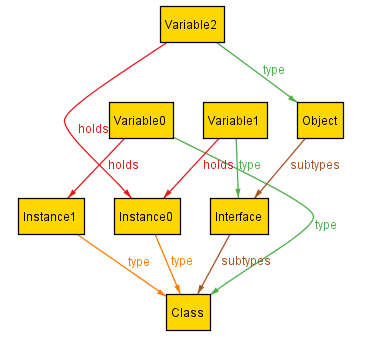
This scenario illustrates a possible instance of the Java type system. It's got one class and one interface definition; the interface extends Object (by default), and the class implements the interface. There are two instances of that class. Variable0 and Variable1 both hold Instance1, and Variable2 holds Instance0.
Alloy provides a Next button that will give us more examples, when they exist. If we keep clicking it, we get a parade of hundreds more:
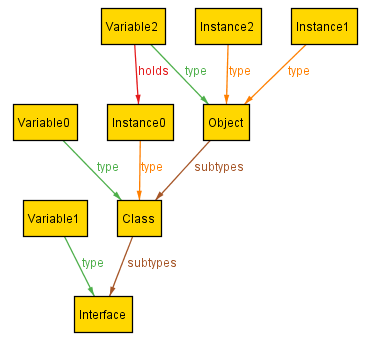
|
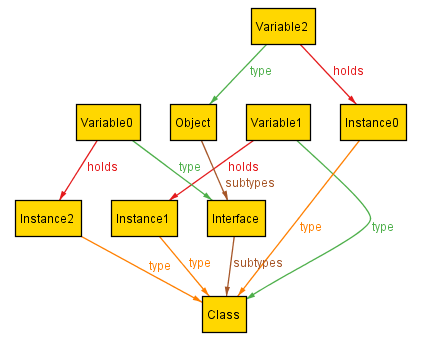
|
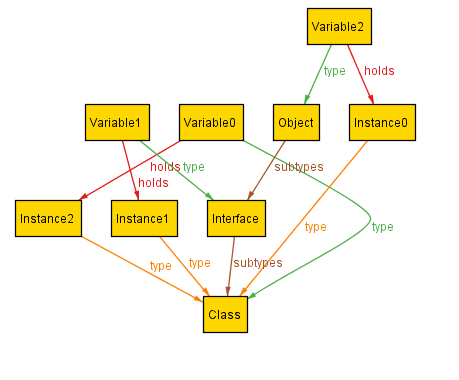
|
Even a small specification like this one, with a relatively small size bound (like 4), can yield many hundreds of scenarios. That's after Alloy has automatically ruled out lots of superfluous scenarios that would be isomorphic to those already seen. Scenario-overload means that the pathological examples--the ones that the user needs to see--may be buried beneath many normal ones.
In addition, the order in which scenarios appear is up to the internal SAT-solver that Alloy uses. There is no way for a user to direct which scenario they see next without stopping their exploration, returning to the specification, adding appropriate constraints, and starting the parade of scenarios afresh. What if we could reduce the hundreds of scenarios that Alloy gives down to just a few, each of which represented many other scenarios in a precise way? What if we could let a user's goals guide their exploration without forcing a restart? It turns out that we can.
Aluminum: Beyond the Next Button
We have created a modified version of Alloy that we call Aluminum. Aluminum produces fewer, more concise scenarios and gives users additional control over their exploration. Let's look at Aluminum running on the same example as before, versus the first scenario that Alloy returned:

The 1st Scenario from Alloy |
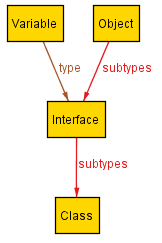
|
Compared to the scenario that Alloy produced, this one is quite small. That's not all, however: Aluminum guarantees that it is minimal: nothing can be removed from it without violating the specification! Above and beyond just seeing a smaller concrete example, a minimal scenario embodies necessity and gives users a better sense of the dependencies in the specification.
There are usually far fewer minimal scenarios than scenarios overall. If we keep clicking Next, we get:
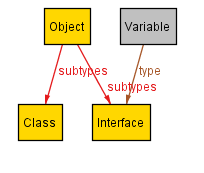
|
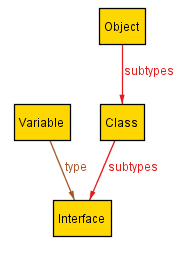
|
Asking for a 4th scenario via Next results in an error. That's because in this case, there are only three minimal scenarios.
What if...?
Alloy's random, rich scenarios may contain useful information that minimal scenarios do not. For instance, the Alloy scenarios we saw allowed multiple variables to exist and classes to be instantiated. None of the minimal scenarios illustrate these possibilities.
Moreover, a torrent of scenarios--minimal or otherwise--doesn't encourage a user to really explore what can happen. After seeing a scenario, a user may ask whether various changes are possible. For instance, "Can I add another variable to this scenario?" More subtle (but just as important) is: "What happens if I add another variable?" Aluminum can answer that question.
To find out, we instruct Aluminum to try augmenting the starting scenario with a new variable. Aluminum produces a fresh series of scenarios, each of which illustrates a way that that the variable can be added:
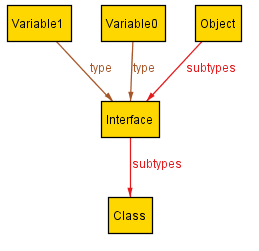
|
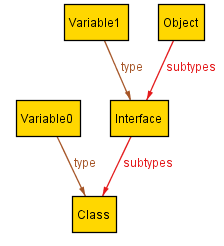
|
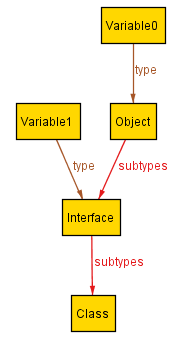
|
(The newly added variable is Variable0.)
From these, we learn that the new variable must have a type. In fact, these new scenarios cover the three possible types that the variable can receive.
It's worth mentioning that the three augmented scenarios are actually minimal themselves, just over a more restricted space—the scenarios containing the original one, plus an added variable. This ensures that the consequences shown are all truly necessary.
More Information
To learn more about Aluminum, see our paper and watch our video here or download the tool here.
